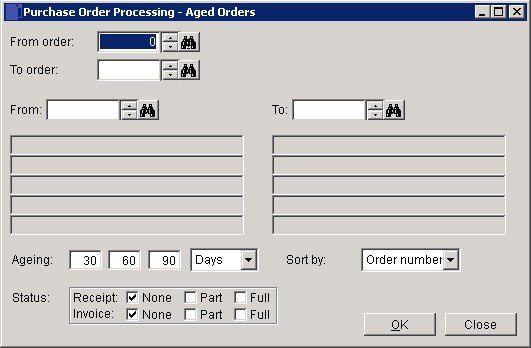POP – Open Purchase Orders By Age
Purpose:
Use this to help identify orders that are overdue for receipt.
The report ages the orders according to the Required Date and displays orders by supplier grouped into current (i.e. due now) and successively earlier periods 1, 2 & 3. Receipt date is calculated as Required Date less the delivery lead time set in Purchase Order Processing Parameters.
Preparation:
For first time use only: On the main menu click View > Parameters > Purchase Order Processing > General > Default period for Aged Orders/Order Action report – drop down – select Days or Months; Input ageing periods from left to right (shortest period overdue first).
For first time use only; On the main menu click View > Parameters > Purchase Order Processing > General > Default No. Days Ahead for Required Date. This sets a default lead time date for delivery, This can be overwritten when raising the purchase order.
Processing:
On the main menu click Orders > Suppliers > Reports > Aged Orders, or click Report Control button – P.O.P. > Aged Orders button to open form.
Select printer – see Printing Reports.
Populate form as required – see Purchase Order Processing – Aged Orders Form – below.
Click OK to print/display/export to selected file type.
Close form.

Select Order and Supplier ranges
Ageing: The ageing of an order is based on the amount of time that has passed between the Transaction’s Entry Date and the Default Transaction Date.
This then applies to all three periods. Each period may then have its own amount of time which does not have to be a multiple of any other period but must be greater than the prior period and less than the next. The periods are numbered 1 through 3 starting from the left.
Orders are reported as being current, i.e. less old than period 1, equal to or older than Order or Account Number order period 1 and younger than period 2, equal to or older than period 2 and younger than period 3, and equal to or older than period 3.
Sort by: Status:
The system allows you to part deliver and part invoice a sales order any number of times before you finally complete or cancel the order. Every item on an open order and an order itself can have nothing delivered (None), part of the order quantity delivered (Part) or all of the order quantity delivered (Full). Similarly an open order can be not yet invoiced at all (None), invoiced in part (Part) or in full (Full). Choose the combination of check boxes to produce the report containing only those orders that satisfy the selection. The check boxes are “sticky” so the combination you select will be remembered the next time you use the form. Some check boxes will be greyed out if your parameter settings disable that part of the order process.


0 Comments